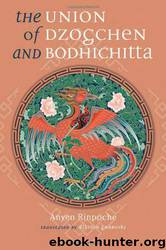The Union of Dzogchen and Bodhichitta: A Guide to the Attainment of Wisdom by Anyen Rinpoche & Allison Graboski

Author:Anyen Rinpoche & Allison Graboski
Language: eng
Format: azw3
Tags: Religion, Buddhism, Rituals & Practice, Tibetan, General
ISBN: 9781559392488
Publisher: Snow Lion Publications
Published: 2006-12-15T02:00:32+00:00
To develop the concentration of the mind further, we can use the technique of meditating upon an object. Although I have said that when we meditate upon the view we should always keep the eyes open, for this shamatha technique it is important to practice with the eyes closed. First, with our eves open, we should focus on an object like a statue, the shape of a mantric syllable like OM or HUM, a thangka, or any other object we find suitable, without moving either our eyes or our mind. Any sound that comes into our ears, smell perceived by the nose, or any other kind of conceptual thought should be cut off and we should focus only on the object on which we are concentrating. If we find that our meditation becomes one-pointed, we should close our eyes and visualize the object as clearly as if our eyes were still open. When we are distracted by discursive thoughts or our visualization becomes unclear, we should open our eyes again and once again focus on the meditation object. In this style of meditation, we are actively trying to abandon anything that distracts us and to concentrate exclusively on the meditation object.
After we have progressed in this style of meditative concentration, we should then train in seeing all appearances as the bodies of the Buddhas and Bodhisattvas. Whatever sounds we hear, we should train in hearing them as mantric syllables and joyful prayers. By practicing in this way, gradually all of the objects perceived by the five sense faculties and by the mind can be used to train in one-pointed meditative concentration. Thus, it is said in the Teachings that if we become skilled at meditative concentration, no matter what appearances, sounds, tastes, smells, or tactile sensations are experienced, we will find that they are unable to disturb us or break our meditation.
It is important not only to transform what is perceived by the five sense faculties into pure appearances, but also what is perceived by the mind. In terms of taking up the uncontrived view of Dzogchen, gaining experience in this type of training is quite essential. In the Dzogchen Teachings, we are told to perceive all appearances as the mandala of the body, all sounds as the mandala of speech, and all thoughts and memories as the mandala of the mind. Here, "body, speech, and mind" refer to the body, speech, and mind of the Buddhas and Bodhisattvas. If we do not gain experience in this type of shamatha, and instead just try to take up the practice of pure perception as it is presented in the Dzogchen Teachings, it may sound good to say that we perceive "all as the mandala," but our practice may not amount to much more than these words.
Download
This site does not store any files on its server. We only index and link to content provided by other sites. Please contact the content providers to delete copyright contents if any and email us, we'll remove relevant links or contents immediately.
The Way of Zen by Alan W. Watts(6292)
Ego Is the Enemy by Ryan Holiday(4963)
The Art of Happiness by The Dalai Lama(3851)
The Book of Joy by Dalai Lama(3704)
Why Buddhism is True by Robert Wright(3290)
Spark Joy by Marie Kondo(3089)
Shift into Freedom by Loch Kelly(3031)
Happiness by Matthieu Ricard(2888)
A Monk's Guide to a Clean House and Mind by Shoukei Matsumoto(2786)
The Lost Art of Good Conversation by Sakyong Mipham(2443)
The Meaning of the Library by unknow(2390)
The Third Eye by T. Lobsang Rampa(2174)
The Unfettered Mind: Writings from a Zen Master to a Master Swordsman by Takuan Soho(2160)
Red Shambhala by Andrei Znamenski(2073)
Anthology by T J(2047)
The Diamond Cutter by Geshe Michael Roach(1957)
Thoughts Without A Thinker: Psychotherapy from a Buddhist Perspective by Epstein Mark(1899)
Advice Not Given by Mark Epstein(1766)
Twilight of Idols and Anti-Christ by Friedrich Nietzsche(1764)
